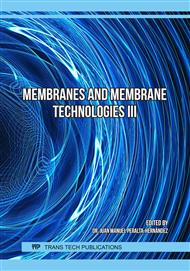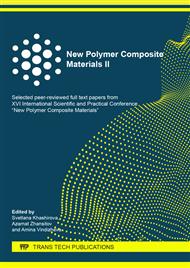[1]
E. Chabanon, D. Roizard, E. Favre, Membrane contactors for postcombustion carbon dioxide capture: a comparative study of wetting resistance on long time scales, Ind. Eng. Chem. Res. 50 (2011) 8237-8244.
DOI: 10.1021/ie200704h
Google Scholar
[2]
S. Zhao, P.H.M. Feron, L. Deng, E. Favre, E. Chabanon, S. Yan, J. Hou, V. Chen, H. Qi, Status and progress of membrane contactors in post-combustion carbon capture: A state-of-the-art review of new developments, J. Membr. Sci. 511 (2016) 180-206.
DOI: 10.1016/j.memsci.2016.03.051
Google Scholar
[3]
E. Chabanon, R. Bounaceur, C. Castel, S. Rode, D. Roizard, E. Favre, Pushing the limits of intensified CO2 post-combustion capture by gas–liquid absorption through a membrane contactor, Chem. Eng. Process.: Process Intensif. 91 (2015) 7-22.
DOI: 10.1016/j.cep.2015.03.002
Google Scholar
[4]
A. Bello, R.O. Idem, Pathways for the formation of products of the oxidative degradation of CO2-loaded concentrated aqueous monoethanolamine solutions during CO2 absorption from flue gases, Ind. Eng. Chem. Res. 44 (2005) 945-969.
DOI: 10.1021/ie049329+
Google Scholar
[5]
A. Bello, R.O. Idem, comprehensive study of the kinetics of the oxidative degradation of CO2 loaded and concentrated aqueous monoethanolamine (MEA) with and without sodium metavanadate during CO2 absorption from flue gases, Ind. Eng. Chem. Res. 45 (2006) 2569-2579.
DOI: 10.1021/ie050562x
Google Scholar
[6]
C. Gouedard, D. Picq, F. Launay, P.-L. Carrette, Amine degradation in CO2 capture. I. A review, Int. J. Greenh. Gas Control. 10 (2012) 244-270.
DOI: 10.1016/j.ijggc.2012.06.015
Google Scholar
[7]
S. Bazhenov, A. Rieder, B. Schallert, V. Vasilevsky, S. Unterberger, E. Grushevenko, V. Volkov, A. Volkov, Reclaiming of degraded MEA solutions by electrodialysis: Results of ED pilot campaign at post-combustion CO2 capture pilot plant, Int. J. Greenh. Gas Control. 42 (2015) 593-601.
DOI: 10.1016/j.ijggc.2015.09.015
Google Scholar
[8]
J. Franco, D. deMontigny, S.E. Kentish, J.M. Perera, G.W. Stevens, Effect of amine degradation products on the membrane gas absorption process, Chem. Eng. Sci. 64 (2009) 4016-4023.
DOI: 10.1016/j.ces.2009.06.012
Google Scholar
[9]
S.D. Bazhenov, E.S. Lyubimova, Gas-liquid membrane contactors for carbon dioxide capture from gaseous streams, Petrol. Chem. 56 (2016) 889-914.
DOI: 10.1134/s0965544116100029
Google Scholar
[10]
E.G. Novitskii, V.P. Vasilevskii, V.I. Vasil'eva, E.A. Goleva, E.A. Grushevenko, A.V. Volkov, Effect of composition and structure of aqueous monoethanolamine solutions on carbon dioxide sorption and desorption in purification of gas mixtures, Russian J. Appl. Chem. 91 (2018) 813-821.
DOI: 10.1134/s1070427218050129
Google Scholar
[11]
E.G. Novitskii, V.P. Vasilevskii, Е.А. Grushevenko, A.V. Volkov, V.V. Volkov, S.D. Bazhenov, Patent RF № 2656661 (2017).
Google Scholar
[12]
G.A. Dibrov, V.V. Volkov, V.P. Vasilevsky, A.A. Shutova, S.D. Bazhenov, V.S. Khotimsky, A. van de Runstraat, E.L.V. Goetheer, A.V. Volkov, Robust high-permeance PTMSP composite membranes for CO2 membrane gas desorption at elevated temperatures and pressures, J. Membr. Sci. 470 (2014) 439-450.
DOI: 10.1016/j.memsci.2014.07.056
Google Scholar
[13]
C.A. Scholes, S.E. Kentish, A. Qader, Membrane gas-solvent contactor pilot plant trials for post-combustion CO2 capture, Sep. Pur. Tech. 237 (2020) 116470.
DOI: 10.1016/j.seppur.2019.116470
Google Scholar
[14]
C.A. Scholes, S.E. Kentish, G.W. Stevens, D. deMontigny, Comparison of thin film composite and microporous membrane contactors for CO2 absorption into monoethanolamine, I. J. Greenh. Gas Control. 42 (2015) 66-74.
DOI: 10.1016/j.ijggc.2015.07.032
Google Scholar
[15]
C.A. Scholes, S.E. Kentish, G.W. Stevens, J. Jin, D. deMontigny, Thin-film composite membrane contactors for desorption of CO2 from monoethanolamine at elevated temperatures, Sep. Purif. Tech. 156 (2015) 841-847.
DOI: 10.1016/j.seppur.2015.11.010
Google Scholar
[16]
H.J. Lee, M.K. Kim, J.H. Park, Decompression stripping of carbon dioxide from rich monoethanolamine through porous hydrophobic modified ceramic hollow fiber membrane contactor, Sep. Pur. Tech. 236 (2020) 116304.
DOI: 10.1016/j.seppur.2019.116304
Google Scholar
[17]
S. Zhao, P.H. Feron, L. Deng, E. Favre, E. Chabanon, S. Yan, H. Qi, Status and progress of membrane contactors in post-combustion carbon capture: A state-of-the-art review of new developments, J. Membr. Sci. 511 (2016) 180-206.
DOI: 10.1016/j.memsci.2016.03.051
Google Scholar
[18]
A. Malakhov, S. Bazhenov, V. Vasilevsky, I. Borisov, A. Ovcharova, A. Bildyukevich, V. Volkov, L. Giorno, A. Volkov Thin-film composite hollow fiber membranes for ethylene/ethane separation in gas-liquid membrane contactor, Sep. Pur. Tech. 219 (2019) 64-73.
DOI: 10.1016/j.seppur.2019.02.053
Google Scholar
[19]
A. Ovcharova, V. Vasilevsky, I. Borisov, S. Bazhenov, A. Volkov, A. Bildyukevich, V. Volkov, Polysulfone porous hollow fiber membranes for ethylene-ethane separation in gas-liquid membrane contactor, Sep. Pur. Tech. 183 (2017) 162-172.
DOI: 10.1016/j.seppur.2017.03.023
Google Scholar
[20]
K. Nagai, T. Masuda, T. Nakagava, B.D. Fridman, J. Pinnau, Poly [1– thrimethilsilyl)-1-propyne] and related pojymers: synthesis, properties and functions, Prog. Polym. Sci. 26 (2001) 721-798.
DOI: 10.1016/s0079-6700(01)00008-9
Google Scholar
[21]
A. Trusov, S. Legkov, L.J.P. van den Broeke, E. Goetheer, V. Khotimsky, A. Volkov, Gas/liquid membrane contactors based on disubstituted polyacetylene for CO2 absorption liquid regeneration at high pressure and temperature, J. Membr. Sci. 383 (2011) 241-249.
DOI: 10.1016/j.memsci.2011.08.058
Google Scholar
[22]
S. Khaisri, D. deMontigny, P. Tontiwachwuthikul, R. Jiraratananon, Comparing membrane resistance and absorption performance of three different membranes in a gas absorption membrane contactor, Sep. Pur. Tech. 65 (2009) 290-297.
DOI: 10.1016/j.seppur.2008.10.035
Google Scholar
[23]
D. de Montigny, P. Tontiwachwuthikul, A. Chakma, Comparing the absorption performance of packed columns and membrane contactors, Ind. Eng. Chem. Res. 44 (2005) 5726-5732.
DOI: 10.1021/ie040264k
Google Scholar
[24]
S. Roussanaly, R. Anantharaman, K. Lindqvist, H. Zhai, E. Rubin, Membrane properties required for post-combustion CO2 capture at coal-fired power plants, J. Membr. Sci. 511 (2016) 250-264.
DOI: 10.1016/j.memsci.2016.03.035
Google Scholar
[25]
K.D. Dorkenoo, P.H. Pfromm, Accelerated physical aging of thin poly[1-(trimethylsilyl)-1-propyne] films, Macromol. 33 (2000) 3747-3751.
DOI: 10.1021/ma9921145
Google Scholar
[26]
D.S. Bakhtin, L.A. Kulikov, S.A. Legkov, V.S. Khotimskiy, I.S. Levin, I.L. Borisov, A.L. Maksimov, V.V. Volkov, E.A. Karakhanov, AV. Volkov, Aging of thin-film composite membranes based on PTMSP loaded with porous aromatic frameworks, J. Membr. Sci. 554 (2018) 211-220.
DOI: 10.1016/j.memsci.2018.03.001
Google Scholar
[27]
Mode list of gas-fractionation plant from Kuibyshevskiy Petroleum Refinery (17.09.2009).
Google Scholar



